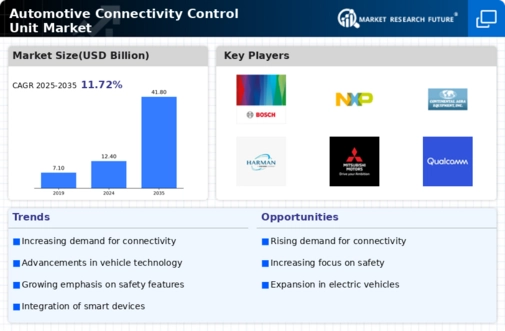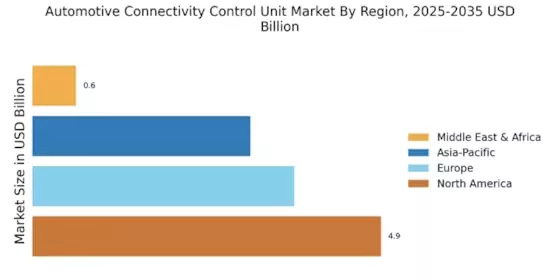Emergence of Electric Vehicles (EVs)
The Automotive Connectivity Control Unit Market is witnessing a transformative shift with the emergence of electric vehicles (EVs). As the automotive landscape evolves, EVs are becoming more prevalent, necessitating advanced connectivity solutions to manage their unique requirements. The integration of connectivity control units in EVs is crucial for optimizing battery management systems and enhancing user experience through smart features. Market forecasts indicate that the EV segment will account for a significant share of the automotive market by 2030, further driving the demand for connectivity control units. This trend underscores the importance of innovation in the Automotive Connectivity Control Unit Market as manufacturers seek to capitalize on the growing EV market.
Rising Demand for Connected Vehicles
The Automotive Connectivity Control Unit Market is experiencing a surge in demand for connected vehicles, driven by consumer preferences for enhanced connectivity features. As vehicles become increasingly integrated with smartphones and other devices, the need for robust connectivity control units becomes paramount. According to recent data, the market for connected vehicles is projected to grow at a compound annual growth rate of approximately 20% over the next five years. This growth is indicative of a broader trend towards digitalization in the automotive sector, where connectivity is no longer a luxury but a necessity. Manufacturers are investing heavily in connectivity solutions to meet consumer expectations, thereby propelling the Automotive Connectivity Control Unit Market forward.
Increased Focus on Infotainment Systems
The Automotive Connectivity Control Unit Market is also being propelled by an increased focus on advanced infotainment systems. Consumers are increasingly seeking vehicles equipped with high-quality entertainment and information systems that integrate seamlessly with their digital lives. The market for automotive infotainment systems is projected to reach USD 30 billion by 2026, indicating a robust growth trajectory. This trend necessitates the development of advanced connectivity control units that can support high-bandwidth applications and multiple connectivity options. As automakers strive to differentiate their offerings, the demand for innovative connectivity solutions within the Automotive Connectivity Control Unit Market is expected to rise significantly.
Regulatory Push for Enhanced Safety Features
The Automotive Connectivity Control Unit Market is being shaped by regulatory initiatives aimed at enhancing vehicle safety. Governments worldwide are implementing stricter regulations that mandate the inclusion of advanced safety features in new vehicles. This regulatory push is likely to drive the demand for connectivity control units that support these features, such as emergency braking systems and collision avoidance technologies. As a result, manufacturers are compelled to invest in advanced connectivity solutions to comply with these regulations. The Automotive Connectivity Control Unit Market is thus positioned for growth as automakers adapt to these evolving safety standards.
Advancements in Vehicle-to-Everything (V2X) Communication
The Automotive Connectivity Control Unit Market is significantly influenced by advancements in Vehicle-to-Everything (V2X) communication technologies. These technologies facilitate seamless communication between vehicles, infrastructure, and other road users, enhancing safety and efficiency. The integration of V2X capabilities is expected to be a key driver for the market, as it allows for real-time data exchange that can improve traffic management and reduce accidents. Industry analysts suggest that the adoption of V2X communication could lead to a reduction in traffic congestion by up to 30%, thereby increasing the demand for sophisticated connectivity control units. As automakers prioritize these technologies, the Automotive Connectivity Control Unit Market is likely to witness substantial growth.

















Leave a Comment